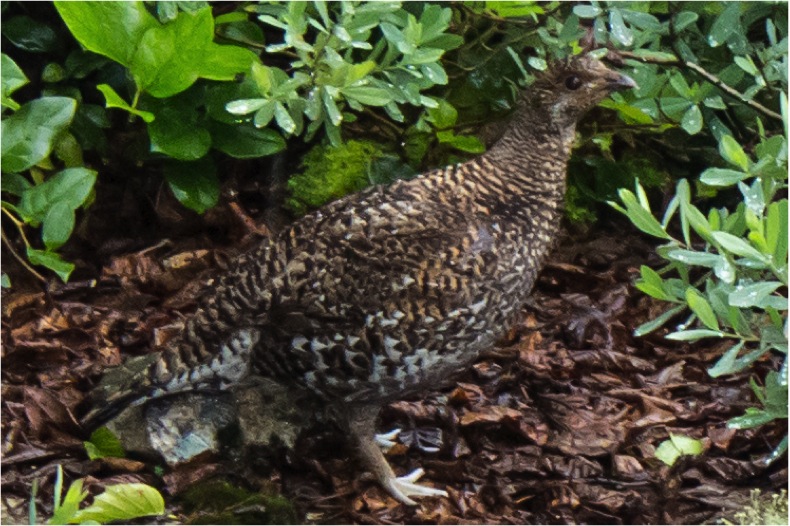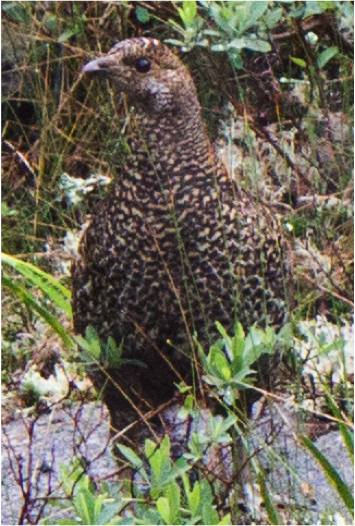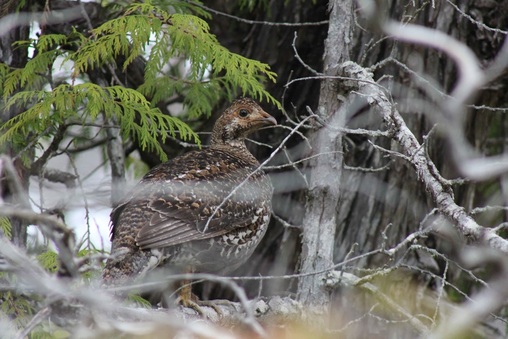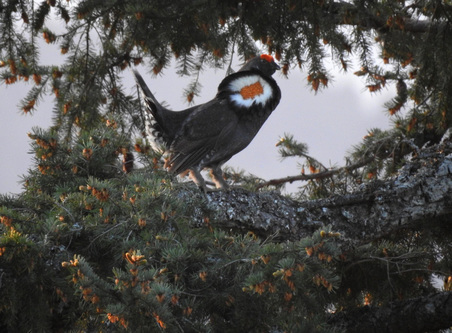Sooty grouse • Dendragapus fuliginosus
Heiltsuk/Haíɫzaqv - mṃ́kḷ́s • Nuxalk - mucwmukwt
Sooty grouse on Calvert Island, photographed by Cody Gold (left), Ian Thomas (top right), and a displaying male (bottom right) by Jody Wells.
Identification
At a weight of up to 1.3 kg and a length of 50 cm this chicken-like bird is one of the largest grouse species in North America and in the world. It has sooty grey or grey-brown plumage with a light band edging the tip of its tail. There is a bare patch of yellowish skin on both sides of the male's neck. The male's call is a deep booming hoot, while the female's call consists of whinnies and cackles.
Habitat & Range
The sooty grouse lives primarily in coastal coniferous forests at low elevations, though may be found in forests of up to thousands of feet in elevation. Its range is from southern Alaska to California, west of the Cascade and Sierra Nevada mountain ranges; it is also found within California's Sierra Nevada mountains.
Find more information at the British Columbia Breeding Bird Atlas here.
Similar Species
The spruce grouse (Falcipennis canadensis) is found in most of BC except for right along the coast; males have red combs above their eyes, and both males and females lack the light tail band of the sooty grouse. The ruffed grouse (Bonasa umbellus) is found all along the BC coast, but can be readily distinguished by its crested head and ruffed neck.
Intriguing Info
In 2006 DNA evidence supported splitting the blue grouse into two species: the western sooty grouse and the eastern (interior) dusky grouse. The sooty grouse had previously been considered a darker coastal subspecies of the blue grouse.
iNaturalist
https://www.inaturalist.org/taxa/72797-Dendragapus-fuliginosus
At a weight of up to 1.3 kg and a length of 50 cm this chicken-like bird is one of the largest grouse species in North America and in the world. It has sooty grey or grey-brown plumage with a light band edging the tip of its tail. There is a bare patch of yellowish skin on both sides of the male's neck. The male's call is a deep booming hoot, while the female's call consists of whinnies and cackles.
Habitat & Range
The sooty grouse lives primarily in coastal coniferous forests at low elevations, though may be found in forests of up to thousands of feet in elevation. Its range is from southern Alaska to California, west of the Cascade and Sierra Nevada mountain ranges; it is also found within California's Sierra Nevada mountains.
Find more information at the British Columbia Breeding Bird Atlas here.
Similar Species
The spruce grouse (Falcipennis canadensis) is found in most of BC except for right along the coast; males have red combs above their eyes, and both males and females lack the light tail band of the sooty grouse. The ruffed grouse (Bonasa umbellus) is found all along the BC coast, but can be readily distinguished by its crested head and ruffed neck.
Intriguing Info
In 2006 DNA evidence supported splitting the blue grouse into two species: the western sooty grouse and the eastern (interior) dusky grouse. The sooty grouse had previously been considered a darker coastal subspecies of the blue grouse.
iNaturalist
https://www.inaturalist.org/taxa/72797-Dendragapus-fuliginosus
References
Sooty Grouse. The Birds of North America Online (A. Poole, Ed.). Ithaca: Cornell Lab of Ornithology. Retrieved from the Birds of North America Online. Accessed 21/11/2014.
Sooty Grouse Dendragapus fuliginosus. Audubon Birds. National Audubon Society. Accessed 24/11/2014.
Authors and editors of page
Kelly Fretwell and Brian Starzomski (2014).
Sooty Grouse. The Birds of North America Online (A. Poole, Ed.). Ithaca: Cornell Lab of Ornithology. Retrieved from the Birds of North America Online. Accessed 21/11/2014.
Sooty Grouse Dendragapus fuliginosus. Audubon Birds. National Audubon Society. Accessed 24/11/2014.
Authors and editors of page
Kelly Fretwell and Brian Starzomski (2014).








